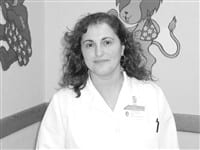Not Just 9-to-5 Care- New Service At Mercy Offers Pediatricians And Parents Options
Almost every parent is familiar with the following scenario. It has either happened to them or somebody they know — guaranteed.
Coming home from work or right after dinner, you’re confronted with a child crying in agony over pain in his or her ear. Because it is after hours, the pediatrician’s office is closed. The options are few, and they are not pleasant. Take a couple of pain relievers (both of you!), and perhaps the child’s discomfort will fade away enough to allow a few hours sleep before you head off to the doctor’s office in the morning.
Or, perhaps worse, endure a long wait in the emergency room. After all, while painful, ear infections are not generally life-threatening, and the harried ER staff will get to you when they can.
Either way, you’re in for a rough night.
Well, not any more. The Pediatric Urgent Care Center at Mercy Medical Center is now open to provide some relief.
“Mercy is not a big pediatric hospital, but we were looking for a way that we could further serve the pediatric community,” said Dr. Teresa Mitchell, medical director of the center and pediatric director of Mercy’s Family Life Center for Maternity.
“We held a meeting about two years ago to see what we could do and what was needed. We invited area pediatricians, and we discussed what their needs are. One of the biggest requests was for an after-hours center where patients could bring children for care that is not of an emergency nature.”
Mitchell’s eyes then lit up as she — herself a pediatrician and mother — said with a laugh, “and almost all pediatric care is ‘urgent care.’”
Plenty of Problems
Such care includes treatment for such things as the ubiquitous ear infections, croup, asthma attacks, sore throats, high fevers, dehydration, minor injuries, and other urgent health problems that are best treated by pediatricians rather then emergency room doctors.
Since the meeting, Mitchell has continued the drive to open such a center. Having a request for such a facility is one thing, but there were questions of feasibility, too. “We did research and marketing studies on whether there would be enough demand for such a facility, and in March of last year, these studies gave the idea a favorable report.”
Then came the problem of finding an appropriate space. To say that what they found was providential may be pushing the term a little, but then again, maybe not. It certainly was most fortuitous, to say the least.
Mitchell told the story. “When we went to look for a space, we found an area with six examining rooms, a waiting room, even an area for the physician to sit and do the paperwork. All it needed was a relatively small purchase of some equipment specific to pediatric care. That was it,” she said.
“We found out it was used only during weekdays for patient pre-assessment for day-stay surgeries. And it was right next to the emergency room! And right down the hall are radiology, phlebotomy, a social worker, and the other services we need access to.”
The fit couldn’t have been more perfect, she continued. “When we showed the administration that we had a space that was already available and there was no need for a capital expenditure, it made their decision easy,” Mitchell pointed out.
The advantages of being near the ER are immeasurable. When patients come to the Pediatric Center, they actually enter through the emergency room entrance. There, they are evaluated by the ER’s triage nurse. If a situation is a true emergency, the patient is sent to the right place for appropriate care. If the young patient has a less serious problem, they turn to the left and see a pediatrician.
This means parents don’t have to worry about making a decision as to the seriousness of their child’s illness or injury. They will be sent to the proper facilities by a medical professional.
Mitchell noted some other advantages. “If a child’s condition suddenly worsens, say from a delayed allergic reaction or a sudden worsening of an asthma attack, the emergency room is right there. That is very rare, but we do have the capability of handling that kind of situation immediately. Conversely, if a child is in the emergency room and the ER doctor is unsure of something, a pediatrician is literally available right next door for a consult.”
Although the two facilities are nearby and can therefore support each other when needed, there are major advantages to having their own areas, too. “It means the parents and children are not subjected to as long as a six-hour wait for relatively minor medical care,” Mitchell said, “and it takes some of the pressure off the ER staff.”
With the sick children in their own area, the chaos of the ER waiting room is also reduced. “An adult waiting for emergency care doesn’t like to have a child crying in the same room because their ear hurts. Our setup is more comfortable for everyone. It’s a nice, quieter space and keeps the two types of patients apart. We wanted our facilities to be separate from the ER for that reason.”
Another key aspect of the service the Urgent Care Center provides is prompt follow-up with the primary pediatrician. “We provide all the information the child’s pediatrician will require, and we can do it quickly,” Mitchell said. “It’s one more way we can provide better service for our young patients and their doctors and at the same time relieve the pressure on the Emergency Room staff.”
Spreading the Word
Mercy’s Pediatric Urgent Care Center is open from 6 to 11 p.m. weeknights, 3 to 11 p.m. on Saturdays, and noon to 11 p.m. on Sundays. According to Mitchell, these are the high-volume times when urgent care treatment is most needed.
The center is staffed by board-certified pediatricians and experienced pediatric nurses. Currently, there are about 13 physicians on staff along with three nurses and two assistants covering the weekly hours. The word has gradually gotten out that this facility is available since opening on Nov. 20.
“We began our marketing efforts to the pediatricians themselves first,” Mitchell said. “We wanted to let them know first. Many people call their doctor first before bringing their child anywhere, and now, if the situation is not a serious one, they are referred here.
“The weekends, naturally, are the busiest time,” she continued. “We now see 14 to 20 patients a day on weekends and six to nine on weeknights. We average about nine a day.” She expects to see that number increase over the coming weeks. “Winter is a busy season for pediatricians. We’ll see our share of flu and bronchial problems in the next few weeks.”
Mitchell noted that the types of cases they see have changed over the first few months. At first, many of the cases were more injury-related, but now, more disease-related cases are coming in.
“That, too, is because we are getting more referrals from pediatricians,” she explained. “Also, people would bring their children to our emergency room for treatment and were sent to the Urgent Care Center.”
This brings up another point important to parents — walk-ins are welcome. Especially at nights and on weekends, that’s a relief to know.



Comments are closed.